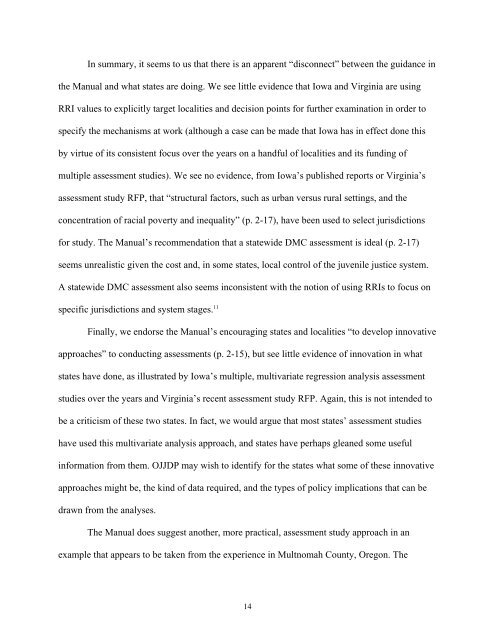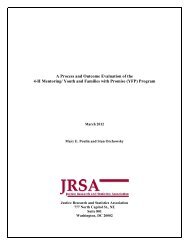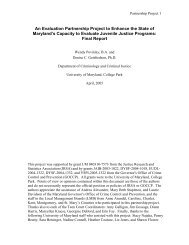A Review of the Status of DMC Efforts in Iowa and Virginia - April 2010
A Review of the Status of DMC Efforts in Iowa and Virginia - April 2010
A Review of the Status of DMC Efforts in Iowa and Virginia - April 2010
You also want an ePaper? Increase the reach of your titles
YUMPU automatically turns print PDFs into web optimized ePapers that Google loves.
In summary, it seems to us that <strong>the</strong>re is an apparent “disconnect” between <strong>the</strong> guidance <strong>in</strong><br />
<strong>the</strong> Manual <strong>and</strong> what states are do<strong>in</strong>g. We see little evidence that <strong>Iowa</strong> <strong>and</strong> Virg<strong>in</strong>ia are us<strong>in</strong>g<br />
RRI values to explicitly target localities <strong>and</strong> decision po<strong>in</strong>ts for fur<strong>the</strong>r exam<strong>in</strong>ation <strong>in</strong> order to<br />
specify <strong>the</strong> mechanisms at work (although a case can be made that <strong>Iowa</strong> has <strong>in</strong> effect done this<br />
by virtue <strong>of</strong> its consistent focus over <strong>the</strong> years on a h<strong>and</strong>ful <strong>of</strong> localities <strong>and</strong> its fund<strong>in</strong>g <strong>of</strong><br />
multiple assessment studies). We see no evidence, from <strong>Iowa</strong>’s published reports or Virg<strong>in</strong>ia’s<br />
assessment study RFP, that “structural factors, such as urban versus rural sett<strong>in</strong>gs, <strong>and</strong> <strong>the</strong><br />
concentration <strong>of</strong> racial poverty <strong>and</strong> <strong>in</strong>equality” (p. 2-17), have been used to select jurisdictions<br />
for study. The Manual’s recommendation that a statewide <strong>DMC</strong> assessment is ideal (p. 2-17)<br />
seems unrealistic given <strong>the</strong> cost <strong>and</strong>, <strong>in</strong> some states, local control <strong>of</strong> <strong>the</strong> juvenile justice system.<br />
A statewide <strong>DMC</strong> assessment also seems <strong>in</strong>consistent with <strong>the</strong> notion <strong>of</strong> us<strong>in</strong>g RRIs to focus on<br />
specific jurisdictions <strong>and</strong> system stages. 11<br />
F<strong>in</strong>ally, we endorse <strong>the</strong> Manual’s encourag<strong>in</strong>g states <strong>and</strong> localities “to develop <strong>in</strong>novative<br />
approaches” to conduct<strong>in</strong>g assessments (p. 2-15), but see little evidence <strong>of</strong> <strong>in</strong>novation <strong>in</strong> what<br />
states have done, as illustrated by <strong>Iowa</strong>’s multiple, multivariate regression analysis assessment<br />
studies over <strong>the</strong> years <strong>and</strong> Virg<strong>in</strong>ia’s recent assessment study RFP. Aga<strong>in</strong>, this is not <strong>in</strong>tended to<br />
be a criticism <strong>of</strong> <strong>the</strong>se two states. In fact, we would argue that most states’ assessment studies<br />
have used this multivariate analysis approach, <strong>and</strong> states have perhaps gleaned some useful<br />
<strong>in</strong>formation from <strong>the</strong>m. OJJDP may wish to identify for <strong>the</strong> states what some <strong>of</strong> <strong>the</strong>se <strong>in</strong>novative<br />
approaches might be, <strong>the</strong> k<strong>in</strong>d <strong>of</strong> data required, <strong>and</strong> <strong>the</strong> types <strong>of</strong> policy implications that can be<br />
drawn from <strong>the</strong> analyses.<br />
The Manual does suggest ano<strong>the</strong>r, more practical, assessment study approach <strong>in</strong> an<br />
example that appears to be taken from <strong>the</strong> experience <strong>in</strong> Multnomah County, Oregon. The<br />
14
















